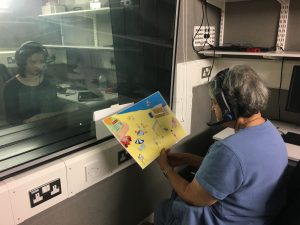Speech communication in older adults: an acoustic and perceptual investigation
ElderLUCID project brochure
Aims
This project investigated the effects of aging on speech communication in good and challenging listening conditions. Are older speakers as able as younger adults to adapt the way that they speak according to the listening conditions they interact in? The ability to produce ‘clear speaking styles’ when the need arises (e.g., due to environmental noise or hearing difficulties of an interlocutor) is essential for efficient communication. We also wanted to see whether having a mild age-related hearing loss affected these adaptations; this is important because age-related hearing loss is the most common sensory deficit in older adults and mild losses are often ignored.
In a second phase of the project, we investigated whether the ‘typical’ and ‘clear’ speech produced by older adults was as intelligible as that produced by young adults, and whether, again, this differed according to the hearing status of the speaker.
Impact
- Even a mild hearing loss in older adults can make it more difficult to do the type of dynamic adaptations in speech production necessary to communicate effectively in challenging communicative conditions. Mild hearing losses should not be ignored.
- The impact of aging on speech production is often under-estimated. Older adults may have problems communicating not only because of hearing difficulties but also because producing clearer speech for the benefit of others is more effortful and less effective than for younger adults.
Key Findings
- There are differences in the acoustic characteristics of speech produced by young and older adults in good listening conditions, and these are mostly linked to physiological differences
When communicating in good listening conditions, older adults, relative to younger adults, typically have a slower articulation rate and less energy in their voice in the mid-frequency range. There is also less differentiation between the pitch of older men and women. These differences are in great part due to physiological differences.
- The presence of a mild hearing loss doesn’t affect the acoustic characteristics of speech produced in good listening conditions.
In older adults, when communication between two speakers is without any interference, the presence or absence of mild age-related hearing loss does not lead to significant differences in the acoustic aspects of their speech.
- In difficult listening conditions, ‘clear speech’ adaptations made by older adults are influenced by the presence/absence of a mild hearing loss.
When you make listening difficult for one speaker in the conversation (e.g., simulate a severe hearing loss), older adults with age-related hearing loss typically show different adaptations while older adults with normal hearing are more similar to young adults. Older adults with hearing loss showed adaptations consistent with an increase in vocal effort (similar to shouting); this was not typically the case for young adults or older adults with normal hearing. Also, older men with hearing loss tended not to slow down their speech to the same degree as other talker groups when talking to someone with a simulated hearing loss.
- In face-to-face communication, older adults with normal hearing look less at their interlocutor.
When individuals could see each other while doing a problem-solving task, older adults with normal hearing looked less frequently and for less time at their conversational partners compared to younger adults. We propose that this may be due to a decline in older adult’s attention to cues signalling how well a conversation is progressing. Older adults with hearing loss looked more frequently and for longer as they have more need for information from visual cues.
- The speech of older adults is not as intelligible as that of young adults, for either young or older adult listeners, but there is clear speech benefit for OA as well as YA speech.
The speech of older adults, when presented in background noise, is not typically as intelligible as that of younger adults, for both young and older listeners. In particular, when speaking normally, older adults with hearing loss were less intelligible for older adult listener groups. However, when they adopted a clear speaking style, older adults with hearing loss were particularly effective and this reduced the cross-group difference in intelligibility.
Overview presentation
Experimental methods – further information
